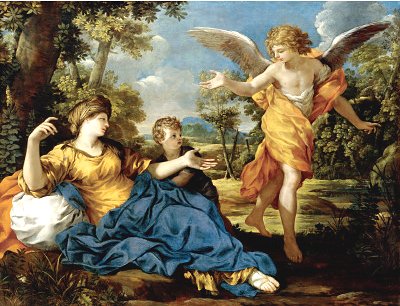HAGAR AND THE ANGEL
SN 132, oil on canvas, 1631-38Pietro Da Cartona
Italian, 1596-1669
ARTIST:
Son of a stone mason, Da Cartona was following in his father’s footsteps when his
obvious artistic talent dictated his re-apprenticeship as a painter. However, his own
studies of antique statuary and works of Raphael and the Caraccis proved more valuable.
Sponsored by the Barberini family, his greatest work was the ceiling in their palace, now
in the National Gallery in Rome. He published Treatise on Painting in 1652. He worked in
Italy, refusing invitations to France and Spain. His many pupils assisted him on frescoes.
The leading painter of Rome’s High Baroque period, da Cartona was 2nd only to Bernini
as architect, decorator, and painter. Only 1 other U.S. museum (in Toledo,Ohio) owns his
work. |
|
 |
SUBJECT:
The Biblical story is from Genesis (21:9-12). Abraham’s wife Sarah had been unable to
bear him a son, so she suggested that her Egyptian maid, Hagar, might be a surrogate. Thus
Ishmael was born. Later, however, Sarah bore Isaac and became jealous of the possible
rival to his inheritance. She persuaded Abraham to banish Hagar and Ishmael to the desert
of Beersheba, with only a little bread and water as sustenance. As they were indeed dying,
an angel appeared (by tradition, the Archangel Michael) & led them to a spring.
Ishmael lived to father the Arab nation, while Isaac became father of the Hebrews.
THE PAINTING:
This painting embodies the wonderful diversity of Baroque in mid-century. Da
Cartona’s work combines the tempestuous Baroque of Rubens with the more classical
elements of Caracci, Reni, and Poussin – thus epitomizing the rift between the 2
major styles of Baroque painting. High Baroque artists aimed for sensuous, exuberant
appeal; Classicists looked back to Roman and Greek tradition with a more intellectual
approach.
Baroque characteristics:
• Catching the moment with dramatic grace and movement. The angel
is stepping forward….there is the ongoing motion.
• Many diagonals, all highlighted – squint and you’ll see
that the hands actually overlap one another.
• The primary colors blue and yellow oppose the complementary
orange, also lending vitality and movement.
• The sensuous mood is reinforced by the lush landscape.
Classical reference:
• Hagar’s pose is straight off a marble frieze. She looks as
if she weighed a ton; you can’t imagine her rising.
• Rather than motion, her body is “stopped dead.”
• Her face is presented in profile.
HISTORIC CONTEXT:
Why is a dying woman looking so gorgeous? Because this is a Counter Reformation painter,
supporting the Church against Luther’s Reformation heresy. The church wants the
message direct, appealing, poignant. Ishmael was, at the time, about 13 – but a
younger child is more appealing. There is a lot of church and palazzo decoration going on
at this time - and who would want to look at a rack of bones? Decoration is decreed to be
pleasant!
ringlingdocents.org
|